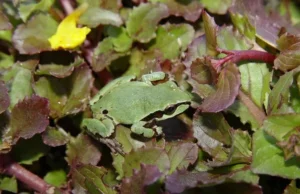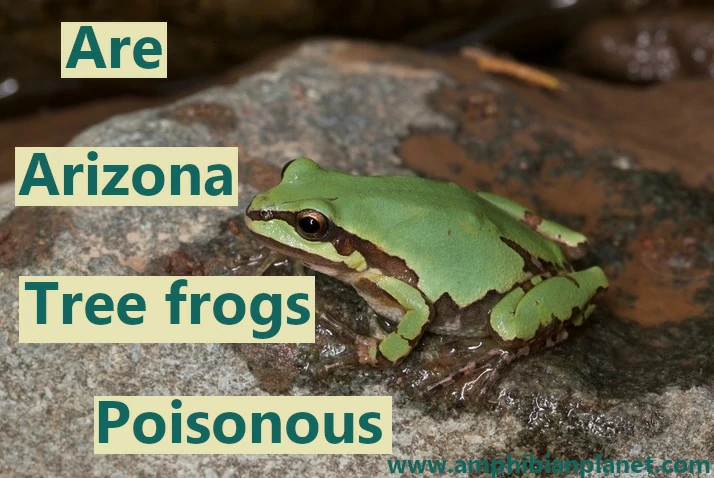Arizona tree frogs (Hyla wrightorum), are medium-sized tree frogs found in the mountains of central Arizona and western New Mexico – with an isolated population in southeastern Arizona. They have a bright green coloration., with a dark, lateral line on each side that may be broken into several segments. But are Arizona tree frogs poisonous?
Arizona tree frogs are mildly poisonous. When threatened, they produce a skin secretion that is toxic or distasteful to many would-be predators. This secretion is very irritating when it comes in contact with your eyes or mucous membranes. It is also irritating to pets that ingest it via the mouth or eyes.
Despite their toxic skin secretion, Arizona tree frogs are usually harmless to humans. Their toxin is only harmful when ingested (such as when you pick up an Arizona tree frog with your bare hands, then rub your eyes before washing your hands).
As a safety precaution, do not touch or handle Arizona tree frogs unless necessary.
If you do handle one, remember to thoroughly wash your hands with antibacterial soap and water after. Do not rub your eyes or stick your fingers into your mouth or nose before washing your hands.
Arizona Tree Frogs Are Only Mildly Poisonous
A dog or cat that has an encounter with an Arizona tree frog and ingests its secretion may salivate excessively or possibly even vomit.
Poisonous but Not Venomous
People often use the words “poisonous” and “venomous” interchangeably, but you should know that these two terms mean very different things.
Most poisonous animals are not venomous, and most venomous animals are not poisonous. Confused?
To make things simple:
- If an animal has to bite or sting you to inject its toxins, it is venomous.
- If an animal secretes its toxins outside of its body, and you absorb the toxins when you come in contact with the animal, it is poisonous.
In other words, Venom is actively injected, usually through stings, fangs, or barbs (think rattlesnakes, scorpions). Poison on the other hand is delivered much more passively and has to be absorbed/ingested into your body.
It can be ingested when it comes into contact with your eyes, lips, the mucus lining of the nose, or open cuts on your skin (think poison dart frogs).

Arizona tree frogs secrete a toxin on their skin, but cannot actively inject this toxin into a predator. This means they are poisonous, but not venomous.
What Other Ways Do Arizona Tree Frogs Defend Themselves?
Apart from a poisonous secretion, Arizona tree frogs have a few tricks to keep predators away.
During the day, their green coloration helps them camouflage or blend into the leaves and other debris in their environments – escaping the notice of predators.

However, sometimes camouflage alone is not enough, so Arizona tree frogs are also strong jumpers. If they see a predator getting too close, they can use can leap away to escape.
They are very acrobatic and will often jump between branches to escape from predators. Arizona tree frogs are also strong climbers and have been found as high as 75 feet in trees.
Are Arizona Tree Frogs Dangerous to Humans?
Although poisonous, Arizona tree frogs typically aren’t dangerous to humans provided they are handled carefully. The only danger comes when their toxic secretions are ingested.
The toxin is not absorbed through your skin but can be absorbed through breaks or cuts on the skin, and the mucous membranes in your eyes, nose, or mouth.
This can happen when you pick up an Arizona tree frog with your bare hands, then rub your eyes, or stick your fingers in your nose or mouth without first washing your hands.
Doing this would enable the toxin to be absorbed by your mucus membranes and likely lead to severe irritation and general discomfort.
If the toxin comes in contact with your eyes, you may get a very painful burning and itching sensation, somewhat similar to the feeling you get when chili gets in your eye. It may even cause inflammation in the mucous membranes of your eyes.
You can also ingest the toxin when you handle an Arizona tree frog with open cuts or scratches on your hands. This would most likely lead to an intense burning sensation and a feeling of numbness at the point of contact.
For this reason, it is a good idea to avoid handling Arizona tree frogs. Although their poison is not lethal when ingested by humans, it can still be severely irritating, particularly when it comes in contact with your eyes.
If you ever need to handle an Arizona tree frog, remember to avoid touching your eyes, nose, or mouth until you have washed your hands.
Also, avoid handling Arizona tree frogs with your bare hands if you have open cuts or scratches on your hands.
It’s Not Just the Toxin You Should Worry About
Like many amphibians, Arizona tree frogs can carry salmonella and other germs that are harmful to humans. Frogs can carry salmonella in their intestines, and pass it off in their waste.
The bacteria do not cause any illness in the frog, so an Arizona tree frog carrying salmonella bacteria may look very clean and healthy, but can pass the bacteria off to humans.
Humans can be exposed to salmonella through contact with the frog, its waste, or anything that the frog touches.

Exposure to salmonella can cause an infection called Salmonellosis which is characterized by stomach cramps, diarrhea, fever, nausea, and sometimes vomiting.
Fortunately, merely touching a frog will not give you a salmonella infection. The bacteria can only cause illness when they are ingested.
Therefore, practicing decent hygiene, and thoroughly washing your hands immediately after touching any Arizona tree frogs should keep you out of harm’s way.
Are Arizona Tree Frogs Dangerous to Dogs or Cats?
Since Arizona tree frogs secrete a toxin, a dog, cat, or any other pet that bites or picks up an Arizona tree frog would get a mouthful of foul-tasting toxin and most likely let go right away.
If a dog (or cat) ingests enough of this toxin, it may droll, foam at the mouth, and in some cases even vomit.
Fortunately, there are no documented deaths or serious injuries of pets that have attacked or tried to eat an Arizona tree frog.
Still, it’s best to keep your dogs, cats, or any other pets away from Arizona tree frogs (and any other frogs) if you can.
Although only mildly poisonous, their secretion is still strong enough seriously irritate a dog (especially small dogs) or cat.
Frogs Can Carry Parasites
As earlier mentioned, frogs can carry salmonella bacteria so a dog or cat that mouths, bites, or eats an Arizona tree frog may ingest the bacteria and develop an infection.
Additionally, frogs are known to carry tapeworms and other parasites. This means if a dog eats an Arizona tree frog, it is not only at risk of poisoning but may also consume parasites and develop a parasitic infection.
Safety Precautions to Take When Handling Arizona Tree Frogs
Amphibians have permeable skin much more sensitive than our skin. They use this skin to breathe, and also to absorb moisture from their environments.
Their skin does not just absorb oxygen and moisture though, anything that comes in contact with the skin can be absorbed; including oils, salts, perfumes, lotions, and other chemicals on your hands.
This means handling an Arizona tree frog with unclean hands can harm and even potentially kill the frog if any chemicals you may have on your hands make their way into its body.
For this reason, it’s advisable to observe frogs from a distance without physically touching them.
If you ever need to handle an Arizona tree frog (such as moving it out of harm’s way), take the following precautions to protect both you and the animal.
Before Handing
- Wash your hands very thoroughly, with dechlorinated water.
- Rinse your hands, and make sure they are very clean and free of all soap residue and other chemicals that could harm the frog.
After washing your hands, make sure they remain moist so you do not dry out the frogs’ skin as you handle it.
When Handling
- Keep the frog away from your eyes nose and mouth and, be very careful not to touch your eyes, nose, or mouth.
- As you handle the frog, do it very gently and with care so you do not injure or stress the frog in any way. Avoid squeezing the frog too hard, or applying too much pressure on it.
Frogs should only be handled for a short time. Handling a frog too long can cause stress to the animal and dry out it is skin.
What to Do After Handling
- Very thoroughly wash your hands with anti-bacterial soap under running water.
Even if you were wearing gloves, it is still a good idea to go the extra mile by washing your hands. As earlier mentioned, Arizona tree frogs secrete a toxin and may carry bacteria that can be harmful, so it’s best to protect yourself.
Before washing your hands, do not touch anything (you could spread bacteria) – and remember not to rub your eyes, touch your face, or put anything into your mouth.
Commonly Asked Questions:
Are Arizona tree frogs poisonous to touch? Arizona tree frogs are indeed poisonous to touch. Remember, they secrete toxins all over their skin, and you can ingest these toxins if you do not wash your hands after touching an Arizona tree frog.
Are Arizona tree frogs poisonous to dogs? Arizona tree frogs produce noxious skin secretions that are poisonous when ingested by a dog. This means if your dog eats, licks, or bites an Arizona tree frog, it may ingest toxic secretions. These secretions are merely irritating, and won’t kill or seriously harm most dogs.
Are Arizona tree frogs poisonous to cats? Since Arizona tree frogs produce toxic skin secretions, they can be poisonous to cats. The secretions produced by Arizona tree frogs are not lethally toxic, so they may irritate but won’t kill or seriously harm most cats.
Do Arizona tree frogs bite? Arizona tree frogs can bite, but this is very rare. They will only nip at a human if they are being handled in a way that causes them a lot of stress. Their bite is nothing to be worried about because it is unlikely to hurt and is not venomous or anything of that nature.
Photo credit: wasatch_hunter (CC BY-NC 4.0)


